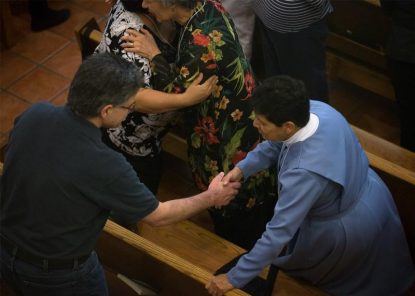
People exchange the sign of peace during Mass at St. Pius X Church in El Paso, Texas, Sept. 23, 2019. (CNS photo/Tyler Orsburn)
A handshake, a nod of the head or a discreet wave had constituted the “sign of peace” at Mass up until the start of COVID-inspired social distancing two years ago.
It has been missing, officially, ever since.
Now the friendly acknowledgment of the other worshipers beside you in the church pew may return to the liturgy beginning this weekend, April 24-25, at Masses celebrated in the Archdiocese of Philadelphia for the Second Sunday of Easter, or Divine Mercy Sunday.
The sign of peace technically is optional during the Communion Rite of the Mass — the Roman Missal directs that, “if appropriate,” the priest or deacon invites the faithful to “offer each other the sign of peace.”
But over time the gesture has become a standard feature of the liturgy for worshipers to offer a warm show of fellowship to one another.
[hotblock]
That ceased as a formality when health and safety protocols in the Philadelphia Archdiocese and everywhere else called for refraining from close contact during the COVID pandemic, even though informally people could turn for a moment and offer a distanced sign of peace.
According to a directive this week from Father Dennis Gill, director of the archdiocesan Office for Divine Worship, the sign of peace during the Eucharistic Prayer expresses the peace of Christ and “prepares for the deepest possible communion with the reception of the Body and Blood of Christ.”
While a handshake normally is to be used for the sign of peace, a similar gesture “should be fitting and sober and extended to those who are nearest,” he wrote.
“Waving and the victory sign would be incompatible gestures with the intended expression of communion with those nearest to one another,” he added.
Given particular circumstances at certain churches, such as when people are “scattered throughout the church and sitting at a distance from one another” the sign of peace remains optional, Father Gill wrote.
PREVIOUS: Family Festival aims to build up families post-pandemic
NEXT: Victoria’s Veselka turns anguish into action for Ukrainian refugees



Share this story